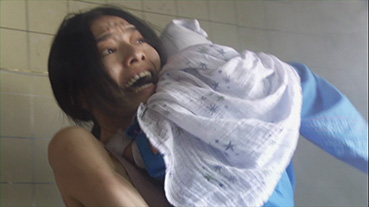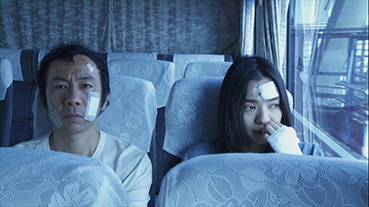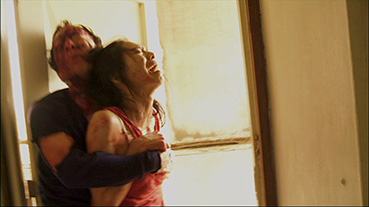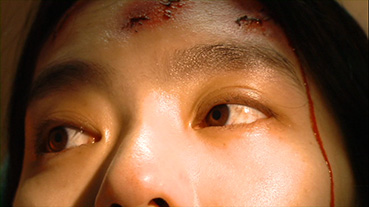|
There are whole sequences in the first half-hour of Kotoko, the latest film from visionary Japanese auteur Tsukamoto Shinya, when you'd be forgiven for wondering if this was the product of the same twisted mind that gave us Tetsuo, Bullet Ballet and Tokyo Fist, to name but three great films in his auspicious 27-year film career. There are, after all, no extremes of body horror and no sign at all of the director's famed love-hate relationship with the city in which he still lives. And the central character here is female, itself a rarity in Tsukamoto's cinema, unless she is sharing story space with an equally troubled or tormented male, of course.
The woman in question here is the titular Kotoko, a single mother struggling with psychological issues and the pressures of raising a small child on her own. The cuts on her forearm are self-inflicted, and she suffers regular assaults at the hands of hallucinated dopplegangers of the people she meets. Her inability to cope eventually results in her child, Daijiro, being taken from her by social services and placed in the care of her distantly located sister, pushing her into a depressive state that leaves her even more emotionally isolated. The only time she appears to be at one with the world is when she loses herself in song, which on one occasion attracts the attention of Tanaka, a celebrated author who, captivated by her singing, tracks her to her home. Initially hostile to his advances, Kotoko eventually allows him into her life, but their relationship proves to be far from the stereotypical romantic norm.

From the opening frames, Tsukamoto adopts a subjective approach in which events are shown very much from Kotoko's skewed viewpoint, the confrontational nature of her visually and aurally jarring hallucinations balanced by her quietly reflective voice-over, which provides enough reality grounding for us to be able to clearly comprehend what is unfolding. And despite the shift towards social realism, there are still some signature Tsukamoto elements at play, notably the melding of camerawork to a character's emotional state, which reaches a dizzying fever pitch as Kotoko struggles helplessly to cook a meal while cradling her unceasingly screaming child, her panic and despair reflected in the hyper-kinetic cinematography and the sensory assault of the sound design.
Then, as Kotoko completes the long journey to her sister's house to spend the day with Daijiro, there is an unexpected shift to an observational approach, one so authentic in technique and performance that you'd swear that you were watching a documentary record of the lead actress visiting her own son during a break in the filming. It's here that that the loving mother buried beneath the surface psychosis is briefly revealed, and there is a very real sense that if reunited with Daijiro and given the appropriate support and help, Kotoko has the potential to function as well as her contented and well-adjusted sibling.
But this proves a temporary reprieve. As she departs from her sister's house and turns her back on her young son, her joy visibly fades, and once home she is only able to express herself through self-harm. It's at a moment of potential suicide that a small ray of hope arrives in the shape of the besotted Tanaka, whose fascination with Kotoko drives him to persist in the face of sometimes hostile resistance. This does provide a few unexpected moments of black humour, as Tanaka twice suffers the same fork-inflicted injury, despite his anticipation of the second assault, and his frantic attempts to stem the bleeding from Kotoko's self-inflicted wounds are frustrated by not being able to locate the appropriate towel.

It's when Kotoko appears to mellow and accept Tanaka's proposal that the film moves into more recognisable Tsukamoto territory. In an astonishing gut-punch of a reveal (and seriously, if you want to go in cold, I'd hop to the next paragraph), Kotoko is shown happily admiring her engagement ring like a fairy tale bride-to-be, which cuts jarringly to the image of Tanaka held upright by electrical cable, his face beaten to a genuinely horrifying pulp. "I overdid it, didn't I?" Kotoko casually remarks (that she says this before we catch sight of Tanaka only adds to the jolt); "I'm OK," Tanaka assures her, to which she responds by lovingly kissing and licking his wounds. Tanaka's painful willingness to suffer such extremes of physical abuse to keep the relationship from coming apart can't help but recall the scene in Tokyo Fist in which lead character Tsuda (also played by Tsukamoto) is only able to emotionally reconnect with his estranged wife Hizuru by allowing her to beat him senseless. Here, however, the assaults are never shown and the act itself offers a cathartic release for neither party nor a workable foundation for a lasting relationship, something Kotoko is painfully aware of but Tanaka blindly denies.
In what is for the most part a one-hander (Tanaka plays only a supporting role), folk-rock singer Cocco may seem a risky choice for a lead role that demands such extremes of emotional expression, but pick any five minutes of the film and you'll be left convinced of the wisdom of Tsukamoto's decision. Her increasing despair and desperation feels heartbreakingly real, and even the singing – which I initially suspected was included solely to make use of the singer's vocal abilities – becomes integral to the character and story structure. Nowhere is this more vividly evident than the electrifying sequence in which Kotoko sings for Tanaka, and what begins as a performance to camera develops over the course of the song into a devastating portrait of emotional and psychological meltdown. It was only after watching the film that I learned that the the character of Kotoko was shaped in part by Cocco's own psychological issues, depression and history of self-harm, and that her sister and the teenage incarnation of her son in the film are played by their real-life equivalent.

The most challenging material is saved for the climactic scenes, when hallucination and reality collide in a brain-battering and kaleidoscopic sequence that peaks in act of violence that, despite its blink-and-you'll-miss-it brevity, goes one shocking step beyond what you'd expect even Tsukamoto to commit to film. But perhaps the biggest surprise of all is saved for the coda, one that clarifies aspects of Kotoko's psychosis and ends on a note of unexpected and deeply touching optimism. It's a pitch-perfect conclusion to an emotionally punishing but brilliantly realised journey, and what may well be Tsukamoto's most intense and psychologically complex work to date.
Kotoko was clearly shot digitally, presumably on HD, and the 1.78:1 anamorphic transfer on the DVD looks terrific, making me wonder just how much better the image on the Blu-ray can be. The colours are rich and vibrant when they need to be (the palette is frequently narrowed to specific tones and tints), the sharpness and detail are exceptional, and the contrast is spot-on. As with many digitally shot films, there is some over-exposure on some elements in brightly lit scenes, but this is still a first-rate job.
Every bit as good is the Dolby 5.1 surround soundtrack, a thunderously excellent mix that showcases the film's superb sound design with striking clarity and a chest-rattling range. Lively and sometimes striking use is made of the full sound stage – the above-mentioned cooking scene is an assault on the senses and the rainfall in the coda is some of the richest and most aurally encompassing I've heard on a DVD soundtrack.
Kotoko Trailer (1:59)
A montage of elements that give a flavour of the film's intensity but can only hint at its emotional impact.

Interview with Director Tsukamoto Shinya (21:45)
Shot in what looks like the same session as the interview on Third Window's simultaneously released Tetsuo double-bill, Tsukamoto here provides some invaluable background detail on the production, including how he and Cocco first met, his intention to make a film that would capture her life, her input on the writing and casting, the response of Cocco's fans to the film, and a whole lot more. He is humble about being the first Japanese director to win the Venice Film Festival's Orizzonti Award, and reveals that the key theme of the film for him was the fear of approaching war.
The usual collection of Third Window trailers is also present.
I'll freely admit that even as a long-standing fan of the cinema of Tsukamoto Shinya, I was left reeling by my first viewing of Kotoko, being genuinely unready for the emotional gut-punch it delivered. The direction and central performance are both outstanding, and while it won't work for everyone, for my money this is one of the finest works yet from one of modern cinema's most talented and criminally unsung auteurs. Third Window's DVD looks and sounds marvellous, and the interview with Tsukamoto actually adds to your appreciation of the film. I'll bet the Blu-ray is something else. Whichever you elect to go for, this comes highly recommended.
|